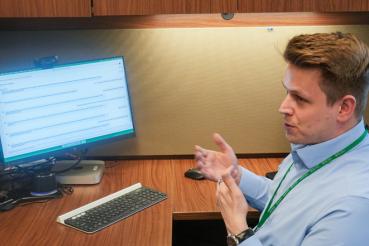Podcast transcript
Can you provide an overview of the scope of the research being undertaken at RUSH around Parkinson’s disease?
In the RUSH Parkinson’s Disease and Movement Disorder program, we have over 7,000 patients who see us with various movement disorders, the majority of which have Parkinson’s disease. We offer around 150 ongoing research projects and about half of those are in Parkinson’s disease and related disorders. So we have a very busy research program.
We have a whole host of different types of research that are available as options for patients. We have observation studies where we look at the clinical phenotype of Parkinson’s disease, the genetics behind the disorder, sleep or other features. We have a number of clinical trials as well, including exercise interventions, medications and gene therapy. And here in the RUSH program we also offer interventions for Parkinson’s disease such as focused ultrasound or deep brain stimulation.
In the RUSH Movement Disorder program, we also offer interventions for Parkinson’s disease including focused ultrasound and deep brain stimulation. And as part of this program, we have a number of research studies, both observational and clinical trials for those patients. The RUSH Parkinson’s Disease Group is known for our clinical and translational research, and hopefully I can give you an idea today of what some of our 17 faculty are working on.
The cause of Parkinson’s disease is unknown and, since we'll be talking about the various ways Parkinson’s disease can develop through the ongoing research that's happening at RUSH, could we briefly talk about several factors that can contribute to the development of Parkinson’s disease?
As you said, for most patients, the cause of Parkinson’s disease is unknown. The patients will come into the clinic and there will be no family history of Parkinson’s disease. They are surprised and their families are surprised that they're now receiving this diagnosis.
Some of these individuals, although it's a very small percentage of them, will have known environmental risk factors such as exposure to pesticides, chemical exposures like our Camp Lejeune patients or have repeated head injuries that we see in our boxers. But for the majority of patients, that is not the case. Another small percentage of patients will come in with a genetic risk factor, and this makes up probably five to 10 percent of the practice where the patient will have a genetic mutation that runs in the family. Sometimes they'll be the first person in the family that will actually come in with symptoms, and so we'll be making that genetic diagnosis for the first time. Other patients will come in and will have multiple family members who are affected. But regardless of the cause, the disease behaves in a similar way in all of these patients in the brain with the spread of this abnormal protein, the alpha synuclein from cell to cell, leading to neuron cell death and progressive clinical abnormalities on the exam.
The first area of research I want to talk to you about is around gene mutations. There are three international multicenter trials going on right now that are looking at targeted pharmacologic interventions and their interaction with certain genes. Before we dive into the specifics of those trials, could you provide some context on the focus and excitement around gene-based therapies for Parkinson’s disease?
This particular area is very exciting right now in Parkinson’s disease, and one of the strategies of the RUSH Parkinson's Program over the last five years has been to personalize treatment for Parkinson’s disease patients. This particular strategy coincides very nicely with a worldwide gene discovery effort to look at the genetic causes of Parkinson’s disease.
There are multiple foundations and national health organizations who have funded this effort, and so researchers and clinicians are working around the clock around the world trying to discover all the gene mutations that can lead to Parkinson's diagnosis. In recognizing that the future of Parkinson’s disease lies in understanding the genetics, several years ago we hired a full-time movement disorder genetic counselor, and we've been building our genetics program with an increase of ordering of gene testing and clinical sequencing, and embarking on this program of clinical trials for patients who have specific gene mutations.
This is a dramatic change in the landscape for the Parkinson’s disease patients. Ten years ago, we would not have offered gene testing necessarily to Parkinson’s disease patients. Now we do so, not only to give a diagnosis, but to open doors for patients for some of these specialized therapies. It really is reminiscent of what has happened in cancer treatment, where we now offer specialized cancer treatment for patients based on their underlying genetic mutations. And so it is very likely the field of Parkinson's is going the same way.
Clinical trials we're offering at RUSH focus on changes in the two most common genes that cause Parkinson’s disease here in the U.S. The first is a gene called GBA or glucocerebrosidase one, and the second gene is called LRRK2 or leucine-rich repeat kinase three. Both of these mutant genes cause an increase of protein buildup in the brain of this alpha synuclein and can cause cell death or apoptosis, and this leads to progressive neurodegeneration of the patient.
The immediate goal of these clinical trials with targeted therapeutics to these gene mutations is to improve the motor signs and the disease, really to improve the day-to-day function of the Parkinson’s disease patients with these gene mutations. However, what we're hoping is that these personalized treatments would be game-changing and slow progression of the disease. We currently do not have any way to slow progression of disease in Parkinson’s disease. So could we, by using this very personalized treatment, facilitate the two pathways that are impacted with these gene mutations and cause them to be more efficient in breaking down that abnormal alpha synuclein and, as a result, slow progression of the disease? The hope is that this indeed would be the case, and this ability to slow down a progression of disease in Parkinson's has been the holy grail of Parkinson’s disease research. And we're hoping that these targeted gene therapy clinical trials will be what we're looking for in this area.
As you mentioned before, there more resources and energies focused in on these gene-related therapies or is it still an even mix of a variety of approaches to looking at studying Parkinson’s disease?
This ability to do clinical trials in specific gene mutations in Parkinson’s disease is new. This has only occurred in the last few years that we've started to see pharmaceutical companies developing this technology. And it really is because there's been such an increase in what is known about the background genetics of Parkinson’s disease that the pharmaceutical companies are now working on therapies for these various mutations. So this is an exciting new development and it also encourages us to think about doing gene testing on our patients in the clinic. If providers in the community don't have the capability to do gene testing, they can be referred to RUSH or another movement disorder practice so that we can offer some of these new clinical trials to these patients.
I want to switch gears and talk about a couple of the trials involving the gut-brain access that you specifically are involved with. The first centers around R.E.M. sleep behavior disorder, which is understood to be a common precursor to Parkinson’s disease. What are you examining in this study?
R.E.M sleep behavior disorder is a sleep disorder where patients act out their dreams. And this can be very problematic in the clinic because patients will injure themselves by falling out of bed or they'll injure their bed partner by hitting them or doing something else because they're moving around during sleep. R.E.M. sleep behavior disorder has been known for years to be a precursor to Parkinson’s disease. A very high percentage of patients with R.E.M. sleep behavior disorder go on to develop Parkinson's. And what we're trying to understand in Parkinson’s disease is whether or not we can identify at the earliest stage signs of the disease even before the patient comes in with a tremor or other signs of Parkinson's.
Now we know in Parkinson’s disease that the microbiome is dysfunctional. When we talk about microbiome, we're talking about the bacteria in the bowel. What are those bacteria that make up the individual bowel of that patient with Parkinson’s disease? And what we know in Parkinson’s disease is that there's more pro-inflammatory bacteria and less of the anti-inflammatory bacteria. And because of this, there's a disruption of the intestinal barrier or bowel wall. So chemicals and especially inflammatory chemicals that would normally go out with the stool are being absorbed potentially into the bloodstream.
Now this is the case in Parkinson’s disease. We don't know what happens in patients who are yet to develop Parkinson’s disease are kind of in what we call the prodrome of the disease. So we are looking at patients with R.E.M. sleep behavior disorder because many of them are going to go on to develop Parkinson’s disease later. We want to understand if they also develop problems with their microbiome, this microbiome dysfunction that I described. It could be that if we do discover these changes in R.E.M. sleep behavior disorder, we may have a biomarker for patients who are going to be developing Parkinson’s disease later. In this particular study we're recruiting patients with and without R.E.M. sleep behavior disorder and Parkinson’s disease, and we're looking at stool bacteria, blood markers and other clinical measures in patients compared to household controls.
The second study looked at the use of a prebiotic fiber bar that may help to improve some Parkinson’s disease symptoms. There are some early promising results that were published in Nature Communications in February 2023 about changing the microbiome of these patients. Can you delve a little bit more into this research and the next steps with it?
In this prebiotic study, our goal was to fix this dysfunctional microbiome and bowel wall integrity barrier dysfunction that I just described. In addition, we were also hoping to help some of the GI symptoms that are common in Parkinson’s disease like bowel constipation. And I'll tell you, as a Parkinson's neurologist, I may spend more time talking to people about constipation than the motor signs of Parkinson’s disease. So this is really important to our patient population. In fact, it's so important that we started one of the first Parkinson’s disease GI clinics in the country here at RUSH. And that's a clinic that I do with my colleague in Ali Keshavarzian in the GI program here in order to have patients have a one-stop shop for their GI symptoms and their Parkinson's.
In this open-label prebiotic bar study, we used a bar that contained fibers that promote small chain fatty acid production. And in this study, after 10 days, our Parkinson's patients had an anti-inflammatory shift in their microbiome with improved intestinal barrier function. That was the goal of the study, and we did see evidence of that when we did testing in the lab. We also showed that the patient's GI symptoms and motor signs improved. And this was surprising after only having the bar for 10 days. I will say that we didn't time it very well because we did the study over Thanksgiving and several of our patients did note that they felt very full after the bar and couldn't enjoy their full Thanksgiving meal. But it was a successful study and we're looking for funding for a much larger clinical trial to try to help the GI symptoms, the motor signs and to normalize the microbiome in these Parkinson's patients.
And would you extend the time that the patients would take this bar longer than the 10-day period of time?
We would expect to extend it six to 12 months at least. It does look like when the patients stop taking the bar their microbiome goes back to what it was before. So it is something that is likely going to be needed for a long-term therapy. I will tell you though, the recruitment for this study is one of the fastest recruitments I've ever done. It seems that Parkinson's patients do find these bowel symptoms to be very problematic and they're very willing to go into clinical trials or to take a dietary supplement if it will help their symptoms.
Switching gears again, I want to ask you about some research going on around optogenetics to learn how gait abnormalities and apathy in deep brain stimulation work. Dr. Lana Kirby received an R21 grant from the NIH to identify biomarkers that could be used to predict when DBS treatment may result in disorders of the mood such as apathy or cognition, and ways to improve DBS protocols to reduce those non-motor-averse effects. Can you provide an update on where this research stands?
Dr. Kirby is using optogenetics to understand what neurons in the brain account for apathy and for gait abnormalities that we see in Parkinson’s disease. And both of these clinical symptoms are difficult to treat and can be seen in side effects after patients have intervention such as deep brain stimulation. So it's very important to try to understand the origin.
This optogenetic technique is a cutting edge technique and it's used in highly sophisticated animal experiments where she can light up specific neurons in the brain as the animal is performing tasks in real time. It's very exciting to see her do this work. She has lots of videos showing us what you can actually see with the optogenetics.
The understanding of the mechanisms of apathy and gait is incredibly important because we don't understand what's happening and, because of that, it's been very difficult to brainstorm and to come up with solutions for these patients. Both apathy and gait abnormalities and Parkinson’s disease respond poorly to medications and interventions and, for this reason, it's really one of the areas of the clinical phenotype that's yet to be treated in a satisfactory way. So, we're hoping that Dr. Kirby will be able to discover much more detail about these pathways, and that will eventually lead to more specific cures for the patients in these two areas.
The last line of research I want to ask you about is around racial disparities in Parkinson’s disease. You received an RO1 grant from the NIH where you looked at clinical characteristics, life experiences and outcomes of Black people with Parkinson’s disease who have been typically underrepresented in the research. Can you talk about what your goals with this study are?
Most of what we know about Parkinson’s disease comes from studies conducted in white populations of patients. RUSH is located in a community that is 30 percent African-American, and as such, it's really important that we extend our knowledge of the disease to specifically help these patients in our community. This NIH grant, which includes six other sites in the country, is working to describe the disease in Black Parkinson’s disease patients.
So we're looking at the clinical features, we're looking at treatment and referral patterns from these patients even before they arrive into the movement disorder practice. And we're looking at the underlying genetic basis. This work is challenging on many levels, but our group at RUSH has developed some programs for the Black community that has helped us partner together better. We have a support group and advisory board for patients of African ancestry and it allows them to give us feedback as we're conducting this type of research on ways that we can improve our messaging, our recruitment or our other techniques.
The goal of this project is really to provide information to both patients and clinicians on a national level. We have several national Parkinson’s disease organizations that are supporting us and will disseminate information when the study is done so that we can provide better care for our Parkinson's patients who are of African ancestry.
And where do you see the research continuing once this RO1 is complete?
The hope would be once we understand whether the disease is the same or different in patients of African ancestry, from that we can determine whether we need to do some additional work as far as an intervention. It could be that the disease is not similar in some ways, and if that's the case, we may need to tailor our treatment, whether it's medication or exercise or other interventions we offer for our patients in the Black community, our Parkinson’s disease patients in ways that are different than the patients that have traditionally been in our studies.
We also may learn from this particular study how best to partner with our Parkinson’s disease patients in the Black community in order to answer some of these research questions. We have recruitment going on at several sites across the country. All of those sites are a little bit different in their makeup of Black patients in their practice. And we're hoping that we can learn best how to create trust in the community and partner together so that we can advance knowledge and move the field forward faster.




